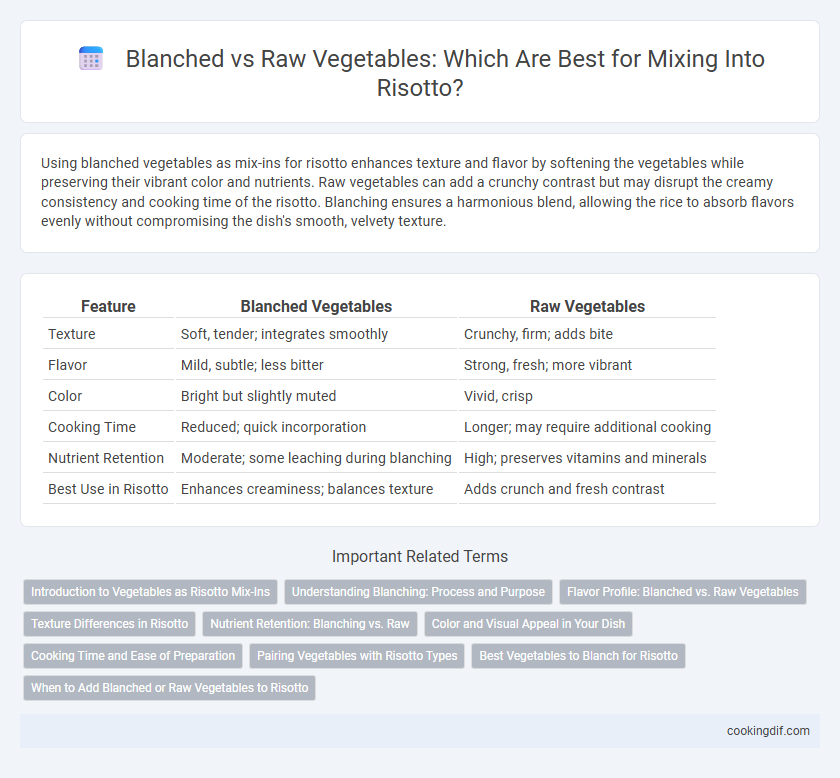Using blanched vegetables as mix-ins for risotto enhances texture and flavor by softening the vegetables while preserving their vibrant color and nutrients. Raw vegetables can add a crunchy contrast but may disrupt the creamy consistency and cooking time of the risotto. Blanching ensures a harmonious blend, allowing the rice to absorb flavors evenly without compromising the dish's smooth, velvety texture.
Table of Comparison
| Feature | Blanched Vegetables | Raw Vegetables |
|---|---|---|
| Texture | Soft, tender; integrates smoothly | Crunchy, firm; adds bite |
| Flavor | Mild, subtle; less bitter | Strong, fresh; more vibrant |
| Color | Bright but slightly muted | Vivid, crisp |
| Cooking Time | Reduced; quick incorporation | Longer; may require additional cooking |
| Nutrient Retention | Moderate; some leaching during blanching | High; preserves vitamins and minerals |
| Best Use in Risotto | Enhances creaminess; balances texture | Adds crunch and fresh contrast |
Introduction to Vegetables as Risotto Mix-Ins
Blanched vegetables enhance risotto by adding tenderness and vibrancy, allowing them to blend seamlessly into the creamy texture without overpowering the dish. Raw vegetables provide a crunchy contrast and fresh flavor, ideal for adding a textural element to risotto recipes. Choosing the right preparation method depends on the desired balance between softness and bite in the final risotto mix-in combination.
Understanding Blanching: Process and Purpose
Blanching vegetables involves briefly boiling them followed by rapid cooling in ice water to halt cooking, which preserves their vibrant color, texture, and nutrients for risotto mix-ins. This process softens vegetables slightly, ensuring they integrate seamlessly into the creamy risotto without becoming mushy or raw-tasting. Unlike raw vegetables, blanched mix-ins maintain an optimal balance between firmness and tenderness, enhancing the dish's overall mouthfeel and flavor harmony.
Flavor Profile: Blanched vs. Raw Vegetables
Blanched vegetables in risotto offer a tender texture and a subtly sweet, mellow flavor that blends seamlessly with the creamy rice, enhancing the dish's overall harmony. Raw vegetables provide a crisp, vibrant contrast with sharper, fresher notes, adding textural complexity and a burst of brightness. Choosing between blanched or raw vegetables depends on whether a softer, integrated flavor or a crunchy, refreshing bite is desired in the risotto mix-ins.
Texture Differences in Risotto
Blanched vegetables in risotto offer a tender yet slightly crisp texture, enhancing the creamy consistency without overpowering the dish's smoothness. Raw vegetables provide a firmer, crunchier bite that contrasts sharply with the soft, al dente rice grains, introducing a diverse mouthfeel. Choosing blanched vegetables maintains harmony in texture, while raw vegetables add pronounced contrast, influencing the overall sensory experience of risotto.
Nutrient Retention: Blanching vs. Raw
Blanched vegetables in risotto retain more nutrients like vitamin C and antioxidants compared to overcooked alternatives, preserving their vibrant color and texture. Raw vegetables offer maximum enzyme activity and vitamin content but may not blend as seamlessly in texture or flavor within the creamy risotto base. Choosing blanched vegetables balances nutrient retention with improved digestibility and integration into the risotto's creamy consistency.
Color and Visual Appeal in Your Dish
Blanched vegetables retain vibrant colors and a tender texture, enhancing the visual appeal of risotto by creating a bright and inviting presentation. Raw vegetables can appear duller and may disrupt the creamy consistency of the dish, reducing overall aesthetic harmony. Using blanched mix-ins ensures balanced color contrast and a polished, professional look in your risotto.
Cooking Time and Ease of Preparation
Blanched vegetables require a brief boiling period followed by immediate cooling, which softens their texture and reduces overall cooking time when added to risotto. Raw vegetables, on the other hand, need longer cooking within the risotto, potentially disrupting the creamy consistency due to uneven cooking. Blanching also enhances ease of preparation by allowing better control over vegetable doneness and texture, ensuring a harmonious blend with the risotto's creamy rice base.
Pairing Vegetables with Risotto Types
Blanched vegetables, such as asparagus or green beans, provide a tender texture and bright color that complement creamy risotto types like Arborio or Carnaroli, enhancing the overall mouthfeel and visual appeal. Raw vegetables, including fresh peas or spinach, add a crisp contrast and fresh flavor, ideal for lighter risottos featuring lemon or herb infusions that highlight their natural vibrancy. Matching vegetables with risotto types ensures optimal flavor balance, texture harmony, and an appealing presentation in each dish.
Best Vegetables to Blanch for Risotto
Blanching vegetables such as asparagus, broccoli, and green beans before adding them to risotto enhances their color, texture, and flavor while preventing overcooking in the creamy dish. This process preserves crispness and brightens the vegetables, ensuring they complement the rich, slow-cooked rice without becoming mushy. Raw vegetables like peas or spinach can be added directly when the risotto finishes cooking, but sturdier vegetables benefit from blanching to maintain their optimal taste and appearance.
When to Add Blanched or Raw Vegetables to Risotto
Blanched vegetables should be added towards the end of risotto cooking to maintain their vibrant color and tender texture without overcooking. Raw vegetables, such as peas or asparagus tips, are best incorporated earlier to allow sufficient time to soften and blend with the creamy consistency. Timing the addition based on vegetable type ensures optimal flavor balance and enhances the risotto's overall texture.
Blanched vegetables vs raw vegetables for mix-ins Infographic

 cookingdif.com
cookingdif.com